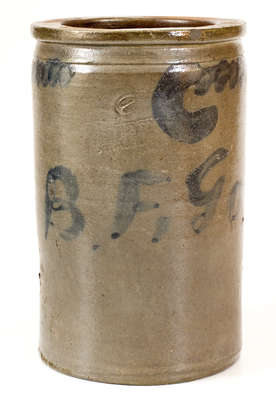Exceptional Early-Period Shenandoah Valley Stoneware Pitcher with Profuse Cobalt Floral Decoration, attributed to Philip Byers, Strasburg, VA origin, circa 1840, ovoid pitcher with tooled rim and ribbed handle, brush-decorated with a central, turnip-shaped design with elaborate, outwardly-branching vines bearing oval and circular flower blossoms. The extensive brushwork continues around the sides of the pitcher and meets at the base of the handle. Dash decoration to spout and broad strokes to the sides of the collar. Cobalt highlights to handle terminals. Shoulder impressed with distinctive raised-face two-gallon capacity mark, in the same series as that found on a one-gallon jar bearing the cobalt inscription, "P Byers 1841," sold as lot 318 in Crocker Farm's May 21, 2005 auction. The history of Philip Byers' career as a potter is outlined in H.E. Comstock's The Pottery of the Shenandoah Valley Region, pp. 381-382. According to Comstock, Byers was apprenticed to Peter Bell in 1823 and by 1831 was probably producing earthenware with Peter Bell and stoneware with William Miller of Strasburg. Byers also may have been the impetus for Peter Bell's venture into stoneware production in 1832. Later in 1832, Byers established a pottery in Rockingham County, VA. By 1839, Byers was working with William Miller's son, John, in Strasburg. Byers began managing the former Miller pottery of Strasburg around 1840, and hired Samuel Bell on occasion to produce some of his ware. According to Comstock, Byers may have persuaded Samuel Bell to move to Strasburg, where Bell and his sons would produce stoneware and redware for the next fifty years. Despite Byers's important role in the Shenandoah Valley potting industry, very few signed or attributed examples of his work are known. This pitcher's capacity mark and unusual, Miller-inspired brushwork lead to a firm attribution to his hand. The significance of this work is compounded by the unusually-elaborate decoration, ranking it among the most heavily-decorated Strasburg stoneware pitchers known. In-the-making damage to top of spout, which is partially glazed over. A chip to interior of spout. Two tiny rim chips. A thin X-shaped crack on underside, including a crack that extends 7" up side of pitcher. A horizontal crack through handle. Some wear to cobalt. A minor, 1 3/4" spider line to one side. Some light staining. H 13 1/2".



















